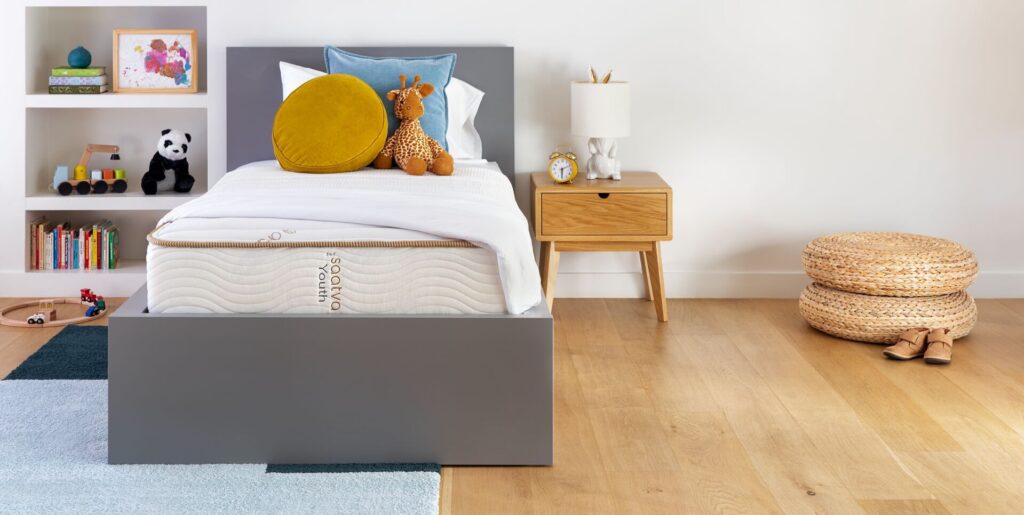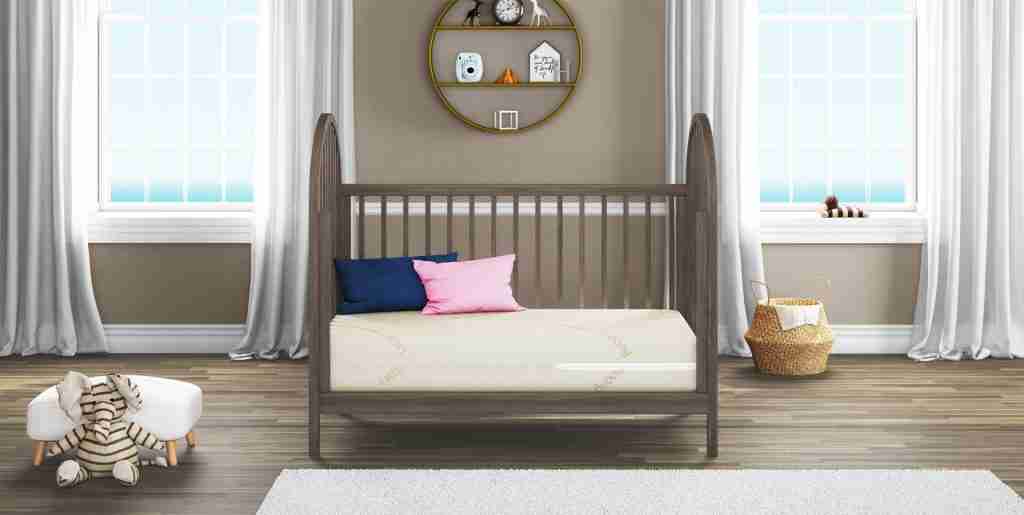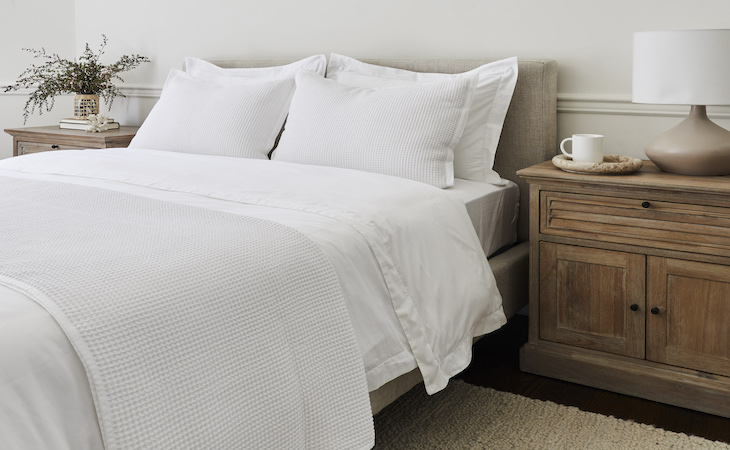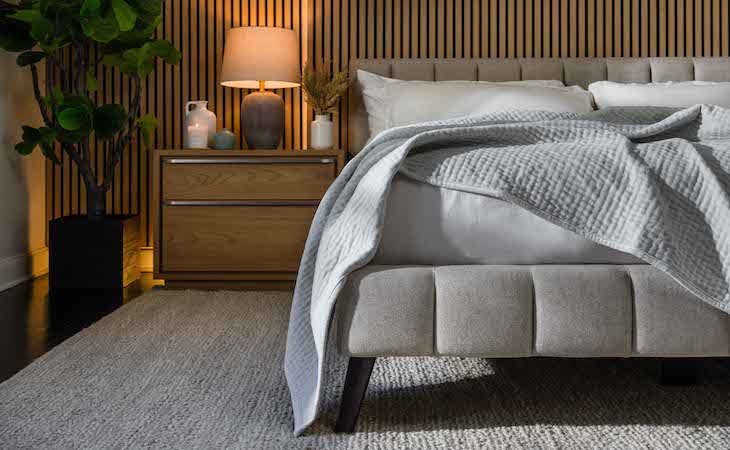
Bedroom Style, Bedroom Styling Guides
September 30, 2025
How to Create a Calming Bedroom for Your Child
Written by Shelby Deering
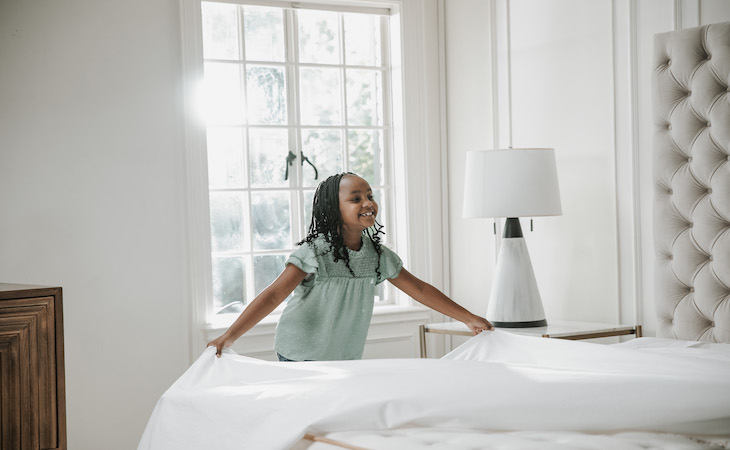
A child’s bedroom can greatly impact their sleep, especially for kids with anxiety or ADHD. A calming space includes dimmable lighting, soft textures, soothing sounds and scents, muted colors, and personal touches. Designing with zones, hidden storage, and gentle shapes supports sensory regulation, emotional wellbeing, and restful sleep.
While you may have put plenty of work into your own bedroom with the goal of achieving quality sleep night after night, perhaps you haven’t given all that much thought to your child’s room and how it can facilitate sleep.
It’s undoubtedly a space where children can play and daydream, but is it a calming environment that helps them unwind at the end of the day and fall asleep peacefully?
It turns out a child’s bedroom set-up can play a big role in their sleep, particularly if they have anxiety or ADHD.
“As parents, it’s easy for us to design our children’s rooms on what we think is best or simply see it as a space for them to sleep and play,” says Klarissa Castro, PsyD, design therapist at Design Shrink Studios. “But I like to offer a different perspective: Their room can become a reflection of who they are as a growing little being.”
A child’s bedroom is a space that can support their development and allow you to watch them evolve, she adds. “When we have that design in mind, their bedroom isn’t just a room—it’s a symbol of their identity and growth,” says Castro.
Ahead, we’ll share how to design a calming bedroom for kids, with tips from Castro.
The importance of a calm environment for a child’s sleep
“A child’s bedroom plays a big role as it’s their sanctuary,” says Castro. “The bedroom becomes a container for safety, routine, and regulation.”
When they feel emotionally and physically safe, it supports better sleep—which then plays a vital role in their emotional regulation, nervous system, and overall mental and physical growth, explains Castro.
To set a soothing scene in your child’s bedroom, you have to get into their shoes. As Castro puts it, you need to step into their world, especially if they have conditions such as anxiety and/or ADHD.
“For a child who has anxiety on a daily basis, their symptoms for example are worry, fatigue, feeling overwhelmed, loss of appetite, and low energy,” she says. “For a child who has ADHD, on a daily basis, they have symptoms of getting easily distracted, losing things, trouble organizing or struggling to follow through on tasks.”
That’s why a child’s bedroom plays two key roles. First of all, sensory regulation is paramount in a child’s bedroom.
“Kids process their world through their senses, so if a room is cluttered, noisy, or overstimulating, it keeps their brain awake,” says Castro. “Their room has to be set up where there is soft lighting, textures and fabrics that are soothing or muted colors in order to help a child be calm and relaxed before going to bed.”
Secondly, there should be a focus on “transition.” A well-designed room can help a child signal to the brain to transition into knowing it’s bedtime.
“Especially for children who have ADHD, they crave stimulation,” she says. “The room can be set up for them to have a bedtime ritual, which will ultimately help them sleep better.”
How to create a calming bedroom for kids
Use dimmable lighting
Since light cues the brain for alertness or rest, you can use dimmable lighting in your child’s room as a signal to start winding down or include a nightlight for comfort and blackout curtains to help with deeper sleep, says Castro.
Include soft textures
“Texture provides tactile comfort and can create a sense of safety and coziness,” says Castro.These can include soft materials such as plush rugs, velvet pillows, chunky knit blankets, or fleece, she adds. “I always like to recommend a weighted blanket to help a child feel calm and contained,” she says.
Quiet noises
Noise has the power to either overstimulate or soothe. Using a white noise machine or soothing soundscapes can help block out the noise in a child’s room, says Castro. Thick rugs, heavy curtains and acoustic wall panels can also help alleviate external noise, she adds.
Soothe with scents
“When you smell something, it triggers your limbic system, which helps you process your memories and emotions,” says Castro. “Using scents like lavender, chamomile, or vanilla can help with relaxation.” Products like essential oil diffusers, incense, or candles can help create a calming aroma, she adds.
Turn to calming colors
Color impacts three things: mood, energy level, and behavior, says Castro. In a child’s room, she suggests using muted calming bedroom colors for kids, like sage green, lavender, or blush tones.
“Overly bright colors like reds and oranges can promote stimulation and heighten awareness,” she says. This is something you don’t want in a bedroom that’s supposed to be calming.
Give it personality
In design psychology, “identity anchors” can be a powerful tool. These are items that can remind a child of who they are and what they like.
“For example, it can be artwork, family photos, or decor with their name on it that can help promote calm and ease,” says Castro. “More importantly, it helps them feel safe and seen.”
Additionally, in order to give your kids ownership of their room, Castro recommends allowing them to choose the color of their room, decor, or even their bedding.
“Being able to pick these things helps them feel more connected to their space,” she notes.
Decorate with round objects
“In design psychology, round shapes are seen as gentle, safe and nonthreatening,” shares Castro. “It’s visually soothing to the brain, creates an atmosphere of calm, and encourages flow where the room can feel open and balanced.”
Break the room into zones
To make the space feel less overwhelming, especially for kids with ADHD, Castro advises breaking the room into different zones for play, sleep, reading, or drawing, which can help a child understand transitions.
Weave in storage
“Visual clutter can be overstimulating and increase anxiety,” says Castro. “Having baskets, drawers, and closed bins to keep their things can help make them not only be organized but helps with their mental and physical clarity.”
FAQs
How do you make a bedroom more ADHD-friendly?
To create a sensory bedroom for kids with ADHD, the goal is to craft a space that supports focus, emotional regulation, and a sense of order without it being too overwhelming, says Castro.
“The room should be calming, predictable, and easy to navigate, or what we call wayfinding,” she says. “Wayfinding helps a child intuitively understand where things go.”
Specifically, Castro recommends things like color-coded storage, labeled drawers and bins, a visual schedule, separate zones, soft lighting, a white noise machine, and clear walkways to make a bedroom more ADHD-friendly.
Does a child with ADHD need their own bedroom?
On one hand, Castro says it can be beneficial for a child with ADHD to have their own room because they’re able to feel control over their environment, support their routines as they have created systems, and act as a private space to be able to emotionally regulate and foster independence.
“However, if they do share a room, it can help them learn how to define their personal zone, create visual boundaries like curtains or room dividers and have clear routines and expectations for both children in the space,” she says. “This sets them up for success in that it provides a space where they can practice what to do if they need to share a bedroom with a sibling, roommate, or a partner in the future.”
What is the most calming color for a kids’ room?
“The color blue helps slow the heart rate, reduce feelings of anxiety and overstimulation, and promote better sleep,” says Castro.
What colors are calming for ADHD children?
Along with the color blue, muted colors like sage green, beige, soft grays, lavender, or blush tones are best for ADHD children, says Castro.
How much sleep do kids really need? Next, check out our guide to children’s sleep needs by age.
Shelby Deering
Shelby Deering is a Madison, Wisconsin-based freelance lifestyle writer contributing home design and health articles to national publications. When she’s not writing, you’ll find her hiking, running, or walking with her husband and corgi, Dolly.
